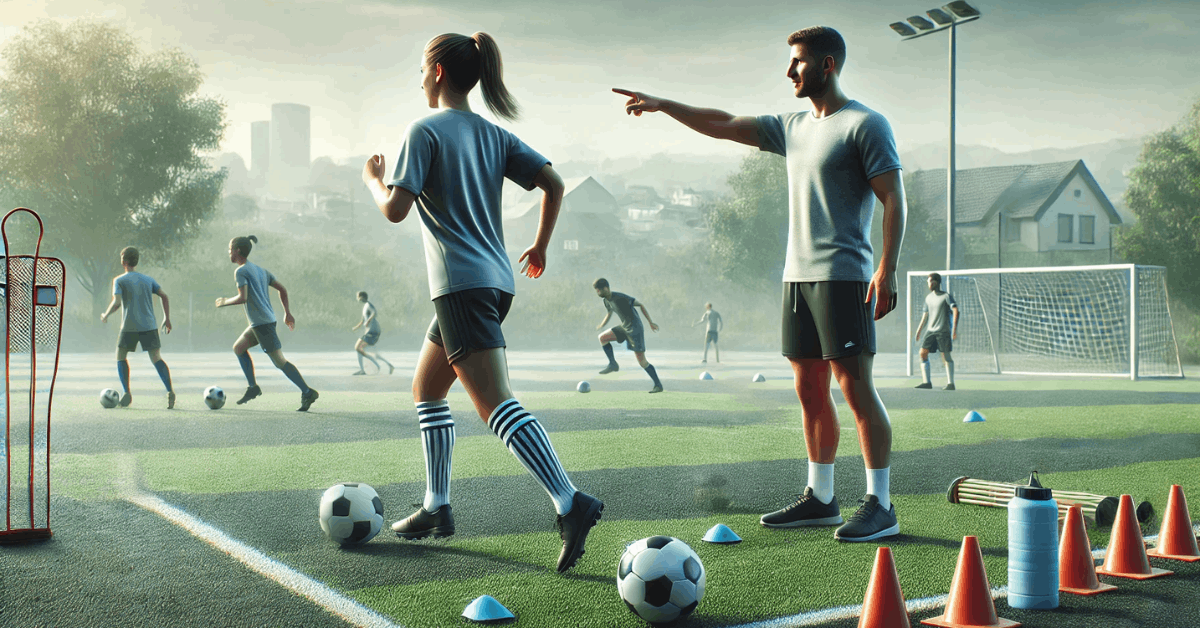
Soccer requires a solid core for injury prevention and better control during gameplay. A strong core helps maintain balance and stability when challenging opponents.
These core exercises target the abs, hips, and shoulders, enhancing overall stability and strength for better soccer performance worldwide.
A Strong and Stable Core Leads to Better Play
Crunches don’t directly improve soccer performance or prevent injuries. If you’re focused on doing hundreds of Crunches weekly, it’s time to rethink your approach.
Instead, prioritize core exercises that enhance both looks and functionality, which actually boost your soccer skills. Ab Crunches alone won’t optimize a soccer player’s performance. The core needs to stabilize the body during soccer movements, not flex the lower back.
Stabilization is key for better movement on the field. You want exercises that support this, not just flex the spine. A solid core gives a soccer player the ability to:
- Stay stable on the plant foot while shooting
- Maintain balance when cutting left or right against defenders
- Shoot without putting strain on the lower back
- Engage hip muscles effectively during powerful shots
- Keep proper posture for faster runs and quicker direction changes
- Breathe better, aiding faster recovery after intense activity
Core stability is critical for improving soccer performance worldwide. Soccer players need to ensure their lower back is stable to protect the spine and train their core as a unified muscle group—hips, lower back, abs, and obliques all working together.
Once the basics like Dead Bugs, Planks, and Pallof Presses are mastered, players shouldn’t stick to the same routine. Diminishing returns kick in. The next step? Add more advanced variations to the workout.
Advanced players should use these basic exercises only for warm-ups or recovery—not for serious training. Now, it’s time to level up those core workouts for serious soccer improvement.
Building Core Strength for Soccer Players: Corrective Exercises and Pars Fractures
Soccer players need core strength to boost performance and reduce injury risk. A strong core helps with agility, power, and stability, making it essential for every player.
Instead of just training, focus on specific corrective exercises designed for soccer athletes. These exercises target core muscles and help improve stability on the field.
They also help prevent injuries like pars fractures. Core strength gives players a better edge in high-intensity matches worldwide. Corrective exercises aren’t optional; they’re necessary to perform at your best.
Importance of Core Strength for Soccer Players
Core strength is vital for soccer players worldwide. It connects the upper and lower body, stabilizing movement. In soccer, sharp turns, fast sprints, and balance are key. A strong core helps players generate more power in kicks, maintain good posture when moving, and reduce the risk of injury.
Corrective Exercises and Techniques
Core strength is essential for soccer players, providing stability, balance, and power in every movement.
The following exercises target the core muscles, correcting weaknesses and enhancing performance on the field.
Each exercise is designed to improve stability, endurance, and strength, making players more agile and injury-resistant.
Anti-Rotation Band Walks
Attach a resistance band around the waist. Step sideways while resisting the band’s pull. This focuses on core strength, especially in the obliques, for stability during lateral soccer movements.
Plank Variations
Engage the full core with forearm planks, side planks, and plank leg lifts. These strengthen the spine and improve endurance, which is key for lasting performance on the field.
Glute Bridges with Marching
Lie on your back, bend knees, and lift your hips into a bridge. Lift one leg at a time while keeping your hips level. This strengthens the glutes, lower back, and hip flexors, improving movement on the soccer field.
Dead Bug Exercises
Lie on the back, arms up, legs at 90 degrees. Lower the opposite arm and leg while stabilizing the core. This builds coordination and core stability, reducing injury risks from poor movement control.
Medicine Ball Rotational Throws
Stand perpendicular to a wall, holding a medicine ball. Rotate the torso explosively, throwing the ball against the wall. Repeat on both sides. This enhances rotational power, which is essential for quick turns and shots in soccer.
Tips to Elevate Your Core Training:
Core strength is essential for soccer players worldwide, providing stability, power, and endurance on the field. Focusing on key training techniques can significantly improve core function, directly impacting performance during games.
- Focused Engagement: Fully engage your core muscles during each movement. This connection strengthens your core muscles faster, improving your soccer performance.
- Increase Intensity: Gradually add resistance and difficulty to core exercises. Consistent increases keep your muscles growing stronger, which is essential for any soccer player worldwide.
- Balanced Exercises: Mix strength, stability, and mobility in your core workouts. A complete approach prevents imbalances that could affect your soccer game.
- Soccer-Specific Core Work: Incorporate core exercises into soccer drills. This method ensures your core is conditioned directly for the sport, creating better on-field results.
- Watch for Injury Risks: Be aware of the risk of Pars Fractures in young soccer players. These stress fractures, common in the lower back, can impact young athletes due to repetitive motions and developing bodies.
Youth soccer athletes are experiencing a rise in Pars Fractures, also known as spondylolysis. These involve a small crack in the thin bone of the spine, specifically the lower back (L5).
Soccer players are at higher risk of injury due to constant back movements and stress. Since their musculoskeletal systems are still developing, youth athletes need extra attention to prevent this injury.
Factors Leading to Pars Fractures in Young Soccer Players
Young soccer players are at risk of developing pars fractures due to the physical demands of the sport.
Understanding the key factors behind these injuries can help prevent them and keep athletes healthy.
- Overuse and Repetitive Stress: Youth soccer players often engage in intense and repetitive training, putting excess stress on their lower backs. Frequent twisting, sprinting, and bending during soccer play can strain the pars interarticularis, increasing the chance of fractures.
- Muscle Imbalances: Weak core muscles and glutes, paired with tight hip flexors, can throw off balance and place extra stress on the lower back, raising the risk of injury during soccer movements.
- Growth Spurts: Sudden growth in adolescence can lead to muscle tightness, affecting spinal stability and raising the chance of pars fractures in young soccer players.
- Improper Technique: Incorrect movements during soccer, such as poor posture when kicking or sprinting, can overload the lower back and increase fracture risk.
Soccer Core Workouts: Essential Exercises to Build a Strong Foundation and Reduce Injury Risk
Soccer demands a strong core to enhance stability, balance, and overall performance on the field.
These essential exercises target the core muscles, helping soccer players build a solid foundation, reduce injury risks, and stay agile during matches worldwide.
Bird-Dog Exercise
Get on all fours. Extend one arm forward and the opposite leg back. Keep your core stable, avoiding any arching.
This move boosts core stability and strengthens spinal muscles, which is key to improving balance and soccer performance.
McGill Curl-Up
Lie on your back, one knee bent, the other leg straight. Lift your head and shoulders slightly while keeping the lower back pressed down.
This exercise strengthens the core, especially the rectus abdominis, without stressing the lower back—perfect for soccer players who need strong core muscles.
Glute Bridge
Lie on your back, knees bent, feet flat on the floor. Lift your hips, squeezing your glutes.
Strong glutes stabilize the pelvis, reducing the stress on the lower back during soccer movements like sprinting and turning.
Cat-Cow Stretch
In a tabletop position, alternate between arching and rounding your back.
This movement promotes spinal flexibility, reduces tension in the lower back, and improves mobility, helping soccer players move more fluidly on the field.
Hip Flexor Stretch
Kneel on one knee, the other foot forward. Lunge forward while staying upright.
This stretch loosens tight hip flexors, reducing lower back strain. Flexible hips are essential for maintaining mobility in soccer.
Conclusion
Incorporating core-focused soccer exercises strengthens the lower back, reduces the risk of injuries, and enhances performance.
Focusing on injury prevention and balanced training helps athletes perform better globally, ensuring long-term success and health.






